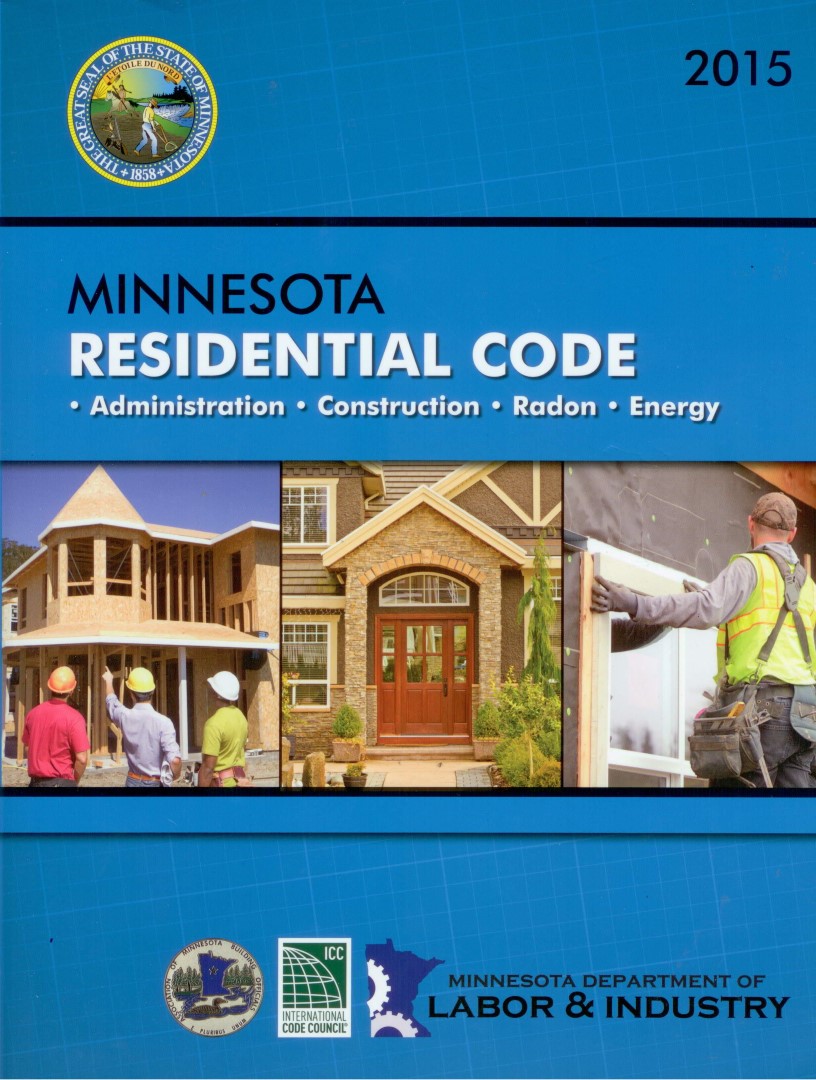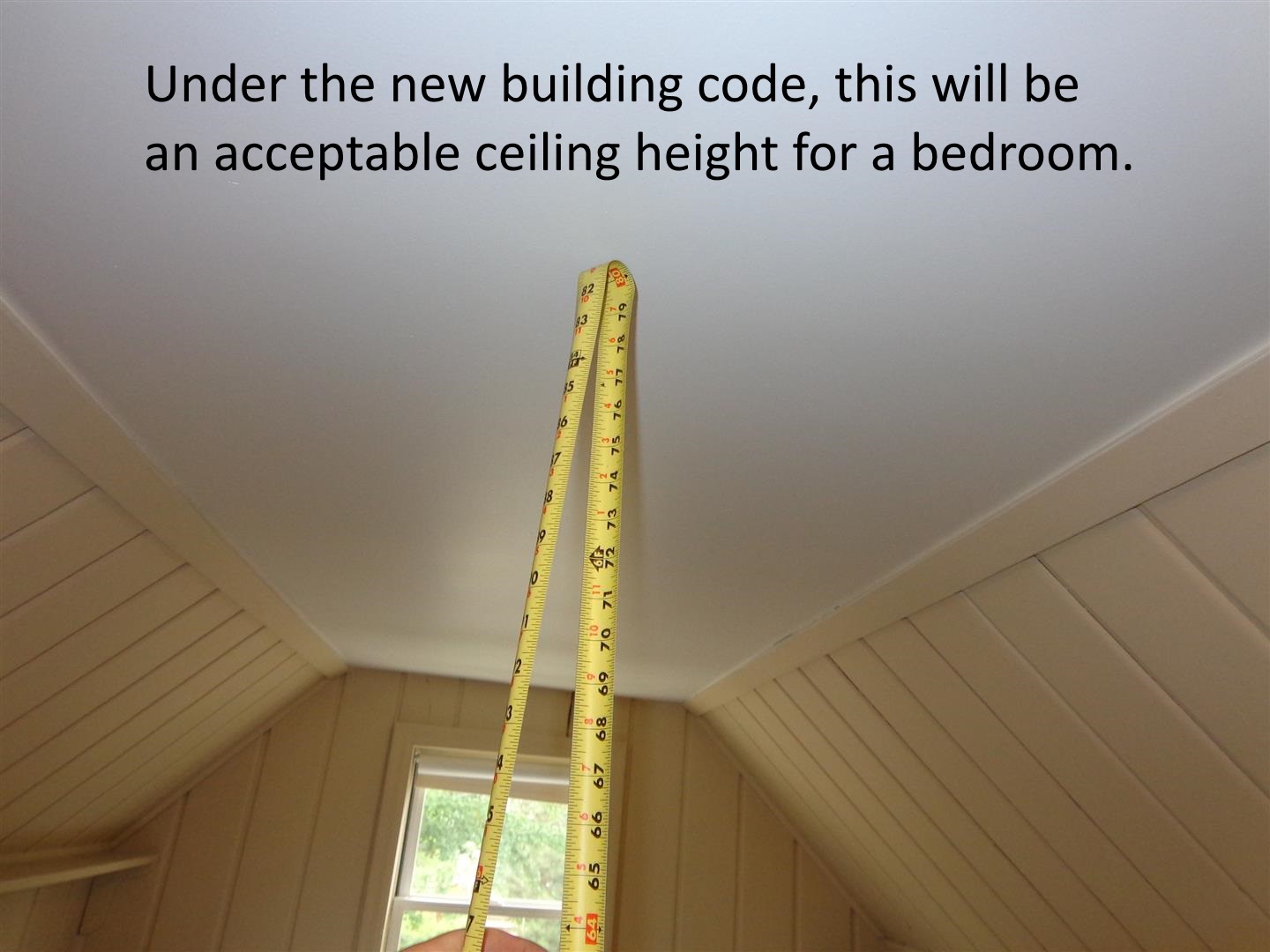Minnesota will be adopting the 2012 International Residential Code (IRC) on January 24th, 2015. With this adoption will come a lot of changes to the existing building code, which was last updated in 2007 when we adopted the 2006 IRC. I’ve put together a list of the things that I feel are the most notable changes.
 One Code Book
One Code Book
This change is extremely helpful. Instead of having to use a copy of the 2012 IRC and then look through the Minnesota Amendments to figure out what’s what, there is now a single book available that combines the 2012 IRC with the Minnesota Amendments. This makes it far easier to look up building codes. This book can be purchased directly from ICC or from Minnesota’s Bookstore.
Less Ceiling Height Needed on Alterations to Existing Homes (R305.2)
The old building code said that habitable rooms, hallways, corridors, bathrooms, toilet rooms, laundry rooms, and basements had to have a ceiling height of not less that 7 feet. This made it impossible to add code-compliant bedrooms in old homes with low basement ceilings. If you had a basement with a ceiling height of 6 feet 10 inches and you wanted to add a bedroom, your options were to either not add a bedroom or just add a bedroom and not pull permits for it.
The new code allows for a basement ceiling height of 6 feet 4 inches on alterations to existing homes. The purpose of this change is to legally allow for habitable use of these basements. Here’s the exact text:
R305.2 Alterations to existing building basements. Alterations to portions of existing basements shall comply with the provisions of this section.
R305.2.1 Minimum ceiling height, existing buildings. Alterations to existing basements or portions thereof shall have a ceiling height of not less than 6 feet 4 inches (1931 mm), including beams, girders, ducts, or other obstructions.
R305.2.1.1 Bathroom plumbing fixture clearance. Bathrooms shall have a minimum ceiling height of 6 feet 4 inches (1931 mm) at the center of the front clearance area for water closets, bidets, or sink. A shower or tub equipped with a showerhead shall have a minimum ceiling height of 6 feet 4 inches above a minimum area 30 inches (762 mm) by 30 inches (762 mm) at the wall where the showerhead is placed. The ceiling may have slopes or soffits that do not infringe on the height required for the plumbing fixture.
R305.2.2 Minimum stairway headroom, existing buildings. Alterations to existing basement stairways shall have a minimum headroom in all parts of the stairway no less than 6 feet 4 inches (1931 mm) measured vertically from the sloped line adjoining the tread nosing or from the floor surface of the landing or platform on that portion of the stairway.
Exceptions: Where the nosings of treads at the side of a flight extend under the edge of a floor opening through which the stair passes, the floor opening shall be allowed to project horizontally into the required headroom a maximum of 4¾” inches (121 mm).
The really interesting part is going to be how this affects TISH evaluation reports. One of the most common comments I put on TISH evaluation reports is about stairways lacking the required headroom of 6 feet 8 inches. Now that the headroom requirement for existing stairways is going to be 6 feet 4 inches, does this mean we won’t have to put down this comment on future TISH reports? I don’t know yet.
 Sprinkler Systems (R313)
Sprinkler Systems (R313)
Automatic fire sprinkler systems are now required in all new townhouses and all new one- and two-family dwellings with 4,500 sf of floor area or more. This new requirement actually made the news last year: http://minnesota.cbslocal.com/2014/07/28/in-home-sprinkler-systems-now-required-in-new-homes/ .
I suspect we’ll be seeing a lot of homes being built just under 4,500 sf. For more info on this new requirement, click here:Residential Fire Sprinkler Systems FAQs
Carbon Monoxide Alarms (R315)
Carbon monoxide alarms have been required by statute in Minnesota for many years now, but it’s finally going to become a rule. This means that CO alarms are going to be required by the building code, which means building officials will be enforcing this rule. Most building officials have already been telling folks they need CO alarms, but they haven’t had any legal right to enforce the installation of CO alarms. Now they do.
One interesting part of this requirement is that carbon monoxide alarms are “required outside and not more than 10 feet from each separate sleeping area or bedroom.”
Fire Protection of Floors (501.3)
For new homes built without automatic fire sprinkler systems, it will no longer be acceptable to leave the unfinished basement floor framing exposed when using an engineered flooring system, which is pretty much the only thing ever used in new construction. This requirement went into effect because floor structures can burn out very quickly on new homes, making it unsafe for fire fighters to enter the building. Here’s the exact code text:
R501.3 Fire protection of floors.
Floor assemblies, not required elsewhere in this code to be fire-resistance rated, shall be provided with a 1/2-inch (12.7 mm) gypsum wallboard membrane, 5/8-inch (16 mm) wood structural panel membrane, or equivalent on the underside of the floor framing member.Exceptions:
1. Floor assemblies located directly over a space protected by an automatic sprinkler system in accordance with Section P2904, NFPA13D, or other approved equivalent sprinkler system.
2. Floor assemblies located directly over a crawl space not intended for storage or fuel-fired appliances.
3. Portions of floor assemblies can be unprotected when complying with the following:
3.1. The aggregate area of the unprotected portions shall not exceed 80 square feet per story
3.2. Fire blocking in accordance with Section R302.11.1 shall be installed along the perimeter of the unprotected portion to separate the unprotected portion from the remainder of the floor assembly.
4. Wood floor assemblies using dimension lumber or structural composite lumber equal to or greater than 2-inch by 10-inch (50.8 mm by 254 mm) nominal dimension, or other approved floor assemblies demonstrating equivalent fire performance.
So what does this mean? At a glance, it would seem that it’s going to be a pain in the butt to finish off unfinished basements, but I’m sure there will be plenty of work-arounds. Under exception #4, there’s some leeway given for “other approved floor assemblies demonstrating equivalent fire performance.” One such product that I suspect building officials will accept is the TJI® Joists with Flak Jacket® protection, shown below.
That’s just one that I’ve heard of. I’m sure there are several more similar products and methods available. I don’t really expect to see a bunch of unfinished basements with drywall covered ceilings, but I guess we’ll have to wait and see.
Kick-out flashing not required when only re-roofing (R903.2.1.1)
In 2007, Minnesota added a requirement for kick-out flashing to be installed “Where the lower portion of a sloped roof stops within the plane of an intersecting wall cladding”. My impression has always been that this is something that should be done as part of any re-roofing or re-siding job, but the building code now specifically says that kick-out flashings don’t need to be installed when only re-roofing. Here’s the exact text:
R903.2.1.1 Existing buildings and structures. Kick-out flashings shall be required in accordance with Section R903.2.1 when simultaneously re-siding and re-roofing existing buildings and structures.
Exception: Kick-out flashings are not required when only re-roofing existing buildings and structures.
Boooooo! I haven’t opined on any of these building code changes, and I’m not going to give my opinion on the wisdom of this one, other than to say I think it’s a completely stupid change. The logic behind this change was that roofers could end up doing more harm than good if they install kick-out flashing on existing siding. I say BS. I’ve seen plenty of botched installations of kick-out flashing, but I haven’t seen a single case where the kick-out flashing even had the potential to do more harm than good.
Oh well. This doesn’t really affect my job; I’m a home inspector, not a building official. I’ll still be recommending the installation of kick-out flashing when it’s not present at houses that I inspect.
Where to find these codes online
The 2012 IRC is available at https://codes.iccsafe.org/content/IRC2012 . Keep in mind, however, that this does not incorporate any of the changes that Minnesota has made to the code.
Minnesota’s code is going to be available online, in one place, here http://www.dli.mn.gov/ccld/codes15.asp. This is a very nice feature, but the link to view the code online is not live as of 1/13/15. The folks at the state tell me it’ll be live before January 24th. I’ll update this blog post as soon as that happens.
Post Update 1/21/15: The 2015 Minnesota State Building Code is now available online, here: http://codes.iccsafe.org/app/book/toc/2015/Minnesota/Residential/index.html


